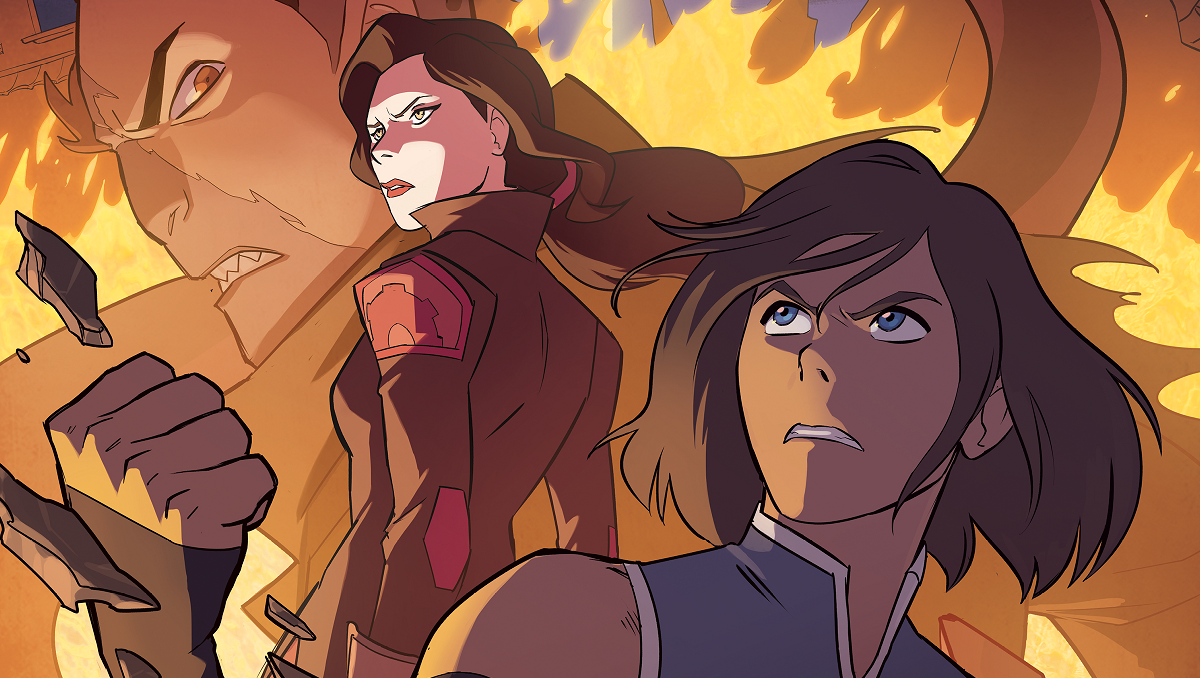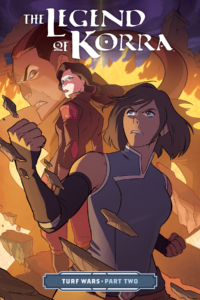
Legend of Korra: Turf Wars Part Two
Writer: Michael Dante DiMartino
Artist: Irene Koh
Colorist: Vivian Ng
Publisher: Dark Horse Comics
A review by Jameson Hampton
 Avatar: The Last Airbender is a series that just won’t die – and that’s a great thing because Avatar is great. The Avatar comics were a great way to extend the series. Now that Legend of Korra is also over, it’s great to see that they’re extending that series via comics as well. Turf Wars Part Two is the most recent addition to that chronicle, coming out from Dark Horse Comics on January 31st, 2018.
Avatar: The Last Airbender is a series that just won’t die – and that’s a great thing because Avatar is great. The Avatar comics were a great way to extend the series. Now that Legend of Korra is also over, it’s great to see that they’re extending that series via comics as well. Turf Wars Part Two is the most recent addition to that chronicle, coming out from Dark Horse Comics on January 31st, 2018.
The first part of Turf Wars, which was released back in July, set up the background for the major conflicts in this series. A wealthy businessman named Wonyong Keum is claiming ownership of the land around the portal to the spirit world, wanting to turn it into a tourist attraction rather than respecting the sacredness of it. A particularly ruthless criminal named Tokuga has taken over the Triple Threats gang and is using them to mess with the portal, getting attacked by a spirit and turned into some sort of spirit monster in the process.
However, the conflict in part one was fairly minimal, allowing the series to focus a little more on Korra and Asami’s new relationship, their romantic vacation to the spirit world and their interactions with their loved ones as they come out as queer. It was beautiful, gentle and supportive – exactly the kind of queer representation that we sorely need in comics.
Turf Wars Part Two, on the other hand, becomes less focused on their relationship and more focused on the problems at hand. All of the issues that were teased in part one become bigger, more urgent problems in part two. The ecology of the spirit world is suffering from the violence that has been happening around the portal. Tokuga, after his transformation, is more powerful – and motivated to cause trouble – than ever. President Raiko continues to be obstinate as ever, getting in the way of the Avatar’s plans and turning people against her to boost his own popularity.
Stress levels are high as bad news befalls Team Avatar from every angle. The relaxed bliss of Korra and Asami’s budding relationship has to take a backburner as this book gives the feel of an oncoming landslide, control slipping away from underneath Korra’s feet, piece by piece. Irene Koh’s art reflects that feeling as well. The coloring in Turf Wars, done by Vivian Ng, is particularly excellent. The way the colors made the spirit world feel truly magical was one of my favorite things about part one and the more ominous coloring in part two was very effective in putting me in a place of anxiety.
The way the comics respect its characters is also noteworthy. I particularly loved to see Zhu Li, who has always been clever and hard-working, getting the credit she’s due from other characters and more importantly, standing up for herself! I always wished that she would stand her ground more often in the show and in this book, it’s great to see her with more agency than ever before, respecting herself and making important decisions with her own wants and needs in mind.
Korra and Asami’s relationship also continues to be treated with respect and maturity, which mainly means here that they treat it more or less like any other relationship. They don’t need to follow a wildly different narrative just because they’re a same sex couple. Asami is used a little bit as the “damsel in distress” in this issue, which is a trope that I’m not necessarily crazy about. Asami is a fully capable woman who doesn’t need to be rescued by the Avatar – and she knows it! But I guess I kind of like that even the villains just want to use Asami to get to Korra, just like is often done with straight couples, rather than being weird about them being together. I just hope that Asami gets her redeeming moment of badassery in the next issue!
Verdict:
Read it! If you’re like me, you need your Korra fix and overall, I think the Turf Wars comics are a worthy inclusion to the Last Airbender universe and a great step forward in terms of queer representation. Yes, watching them come out in part one was cute and fun – and it was a deeply special book to me in that regard! But it’s also good to see reality setting back in for part two, letting this fact about the characters fade into the background where it should be, just one piece of the wonderful people they are.



